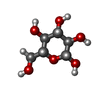+Search query
-Structure paper
| Title | Complete atomic structure of a native archaeal cell surface. |
|---|---|
| Journal, issue, pages | Cell Rep, Vol. 37, Issue 8, Page 110052, Year 2021 |
| Publish date | Nov 23, 2021 |
 Authors Authors | Andriko von Kügelgen / Vikram Alva / Tanmay A M Bharat /   |
| PubMed Abstract | Many prokaryotic cells are covered by an ordered, proteinaceous, sheet-like structure called a surface layer (S-layer). S-layer proteins (SLPs) are usually the highest copy number macromolecules in ...Many prokaryotic cells are covered by an ordered, proteinaceous, sheet-like structure called a surface layer (S-layer). S-layer proteins (SLPs) are usually the highest copy number macromolecules in prokaryotes, playing critical roles in cellular physiology such as blocking predators, scaffolding membranes, and facilitating environmental interactions. Using electron cryomicroscopy of two-dimensional sheets, we report the atomic structure of the S-layer from the archaeal model organism Haloferax volcanii. This S-layer consists of a hexagonal array of tightly interacting immunoglobulin-like domains, which are also found in SLPs across several classes of archaea. Cellular tomography reveal that the S-layer is nearly continuous on the cell surface, completed by pentameric defects in the hexagonal lattice. We further report the atomic structure of the SLP pentamer, which shows markedly different relative arrangements of SLP domains needed to complete the S-layer. Our structural data provide a framework for understanding cell surfaces of archaea at the atomic level. |
 External links External links |  Cell Rep / Cell Rep /  PubMed:34818541 / PubMed:34818541 /  PubMed Central PubMed Central |
| Methods | EM (subtomogram averaging) / EM (single particle) |
| Resolution | 3.46 - 15.87 Å |
| Structure data | EMDB-13632, PDB-7ptp: EMDB-13634, PDB-7ptr: EMDB-13637, PDB-7ptt: EMDB-13638, PDB-7ptu:  EMDB-13639: |
| Chemicals |  ChemComp-CA:  ChemComp-BGC: |
| Source |
|
 Keywords Keywords |  STRUCTURAL PROTEIN / S-layer csg STRUCTURAL PROTEIN / S-layer csg |
 Movie
Movie Controller
Controller Structure viewers
Structure viewers About Yorodumi Papers
About Yorodumi Papers












